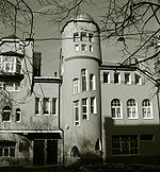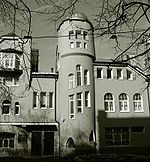
Alexander Zelenko
Encyclopedia

Russia
Russia or , officially known as both Russia and the Russian Federation , is a country in northern Eurasia. It is a federal semi-presidential republic, comprising 83 federal subjects...
n and Soviet architect
Architect
An architect is a person trained in the planning, design and oversight of the construction of buildings. To practice architecture means to offer or render services in connection with the design and construction of a building, or group of buildings and the space within the site surrounding the...
and educator, a pioneer in settlement movement
Settlement movement
The settlement movement was a reformist social movement, beginning in the 1880s and peaking around the 1920s in England and the US, with a goal of getting the rich and poor in society to live more closely together in an interdependent community...
and vocational education
Vocational education
Vocational education or vocational education and training is an education that prepares trainees for jobs that are based on manual or practical activities, traditionally non-academic, and totally related to a specific trade, occupation, or vocation...
. Originally a practitioner of provincial Art Nouveau
Art Nouveau
Art Nouveau is an international philosophy and style of art, architecture and applied art—especially the decorative arts—that were most popular during 1890–1910. The name "Art Nouveau" is French for "new art"...
in Samara
Samara, Russia
Samara , is the sixth largest city in Russia. It is situated in the southeastern part of European Russia at the confluence of the Volga and Samara Rivers. Samara is the administrative center of Samara Oblast. Population: . The metropolitan area of Samara-Tolyatti-Syzran within Samara Oblast...
and Moscow
Moscow
Moscow is the capital, the most populous city, and the most populous federal subject of Russia. The city is a major political, economic, cultural, scientific, religious, financial, educational, and transportation centre of Russia and the continent...
, he later joined the camp of rationalists
Rationalism (architecture)
The intellectual principles of rationalism are based on architectural theory. Vitruvius had already established in his work De Architectura that architecture is a science that can be comprehended rationally. This formulation was taken up and further developed in the architectural treatises of the...
and focused on perfecting school and museum designs.
Biography
Alexander Zelenko grew up in a family of Saint PetersburgSaint Petersburg
Saint Petersburg is a city and a federal subject of Russia located on the Neva River at the head of the Gulf of Finland on the Baltic Sea...
Medical Academy professor. He trained first in Cadet Corps, graduated from Saint Petersburg Civil Engineers Institute in 1892, trained in Vienna
Vienna
Vienna is the capital and largest city of the Republic of Austria and one of the nine states of Austria. Vienna is Austria's primary city, with a population of about 1.723 million , and is by far the largest city in Austria, as well as its cultural, economic, and political centre...
and in Fyodor Shekhtel's firm in Moscow
Moscow
Moscow is the capital, the most populous city, and the most populous federal subject of Russia. The city is a major political, economic, cultural, scientific, religious, financial, educational, and transportation centre of Russia and the continent...
.
Zelenko relocated to Samara
Samara, Russia
Samara , is the sixth largest city in Russia. It is situated in the southeastern part of European Russia at the confluence of the Volga and Samara Rivers. Samara is the administrative center of Samara Oblast. Population: . The metropolitan area of Samara-Tolyatti-Syzran within Samara Oblast...
, bringing Art Nouveau
Art Nouveau
Art Nouveau is an international philosophy and style of art, architecture and applied art—especially the decorative arts—that were most popular during 1890–1910. The name "Art Nouveau" is French for "new art"...
to this Volga town. For a while, he enjoyed steady flow of commissions and the title of Town Architect (1899-1900). Later, he taught in graphic arts in Moscow, travelled to United States
United States
The United States of America is a federal constitutional republic comprising fifty states and a federal district...
in 1903-1904; in this period, Zelenko switched from architectural practice to education.
In 1905 Zelenko joined educators Stanislav Shatsky
Stanislav Shatsky
Stanislav Shatskii was an important late Tsarist and early Soviet humanistic educator, writer, and educational administrator....
and Louise Shleger on their Summer Labor Commune project in Shchyolkovo
Shchyolkovo
Shchyolkovo is a city and the administrative center of Shchyolskovsky District in Moscow Oblast, Russia, located on the Klyazma River , northeast of Moscow. Population: 112,865 ; 109,255 ; 91,000 . The settlement dates back to the 16th century. Town status granted to it in 1925...
, then on Russia's first club for the children. Next year, they set up state-funded Settlement Society for training and professional education. Funded by industrialist Nikolay Krotov, Zelenko designed and built extant Communal Club for the Children in Moscow (completed 1907, Vadkovsky Lane, 5). The castle-like expressionist structure, designed as "inhabitable sculpture", is sometimes compared to Gaudi and Hundertwasser. This club looked after the working teenagers of Moscow's blue-collar North End, and was part of a larger effort to create a new social and educational center in then remote part of Tverskoy and Meshchansky
Meshchansky District
Meschansky District is a district of Central Administrative Okrug of Moscow, Russia. Population: The district extends due north from Kitai-gorod to Kamer-Kollezhsky Val. Western boundary with Tverskoy District follows the track of Neglinnaya River...
Districts.
Settlement was organized in separate boys and girls groups of 12. Each group selected their training schedule, and shaped its own code of conduct. Vadkovsky lane house integrated Settlement program with traditional kindergarten for working families and a two-year junior school. The arts and crafts courses, licensed to "A.U.Zelenko, Architect", catered to around 200 children. Although Zelenko abstained from active politics, police disbanded Settlement on May 1, 1908; Zelenko was jailed for a few months and had to flee to United States again. Upon his return in 1910, he again worked with Shatsky, lectured at the Shanyavsky University and continued architectural practice. Before World War I
World War I
World War I , which was predominantly called the World War or the Great War from its occurrence until 1939, and the First World War or World War I thereafter, was a major war centred in Europe that began on 28 July 1914 and lasted until 11 November 1918...
, he completed highly publicized Pfeffer House in Sokolniki
Sokolniki
Sokolniki may refer to:*Sokolniki District, a district of Eastern Administrative Okrug, Moscow, Russia*Sokolniki, Tula Oblast, a town in Tula Oblast, Russia*Sokolniki, name of several rural localities in Russia...
, Kindergarten in Khamovniki
Khamovniki
Khamovniki District is a district of Central Administrative Okrug of Moscow, Russia. Population: The district extends from Bolshoy Kamenny Bridge into Luzhniki bend of Moskva River; northern boundary with Arbat District follows Znamenka Street, Gogolevsky Boulevard, Sivtsev Vrazhek and Borodinsky...
medical campus and other buildings.
After the Russian Revolution of 1917
Russian Revolution of 1917
The Russian Revolution is the collective term for a series of revolutions in Russia in 1917, which destroyed the Tsarist autocracy and led to the creation of the Soviet Union. The Tsar was deposed and replaced by a provisional government in the first revolution of February 1917...
, and until his death in 1953, Zelenko worked in various Soviet educational institutions, notably in setting architectural standards for schools and kindergartens. Zelenko collaborated in the Museum Commission (1919–1931), designing exhibitions for children (1925–1929) and promoting Alfred Lichtwark's Museumpaedagogic concept. Zelenko, then in his sixties, also collaborated with Nikolai Ladovsky
Nikolai Ladovsky
Nikolai Alexandrovich Ladovsky was a Russian avant-garde architect and educator, leader of the rationalist movement in 1920s architecture, an approach emphasizing human perception of space and shape...
on his Linear city
Linear city
The linear city was an urban plan for an elongated urban formation. The city would consist of a series of functionally specialized parallel sectors. Generally, the city would run parallel to a river and be built so that the dominant wind would blow from the residential areas to the industrial strip...
urban concept.
Buildings
- 1900 Reshetov House, Samara, Kuibyshevskaya, 48
- 1903 Kurilin House, Samara, Frunze, 159 (http://oldsamara.samgtu.ru/part_1/page_5-01/html/2001-2/sd2001-08.html, currently Samara Historical Museum)
- 1900s Permyakov House, Samara, Molodogvardeyskaya 70
- 1900s Own House, Samara, Samarskaya 179
- 1905 Commercial College, Samara, corner of Molodogvarseyskaya and Ulyanovskaya
- 1905 Interiors - Tsesarevich AlexeiTsarevich Alexei Nikolaevich of RussiaAlexei Nikolaevich of the House of Romanov, was the Tsesarevich and heir apparent to the throne of the Russian Empire. In English, his title is usually given as Tsarevich, a title that has a separate meaning in Russia. Alexei was the youngest child and only son of Emperor Nicholas II and Empress...
Commercial College, Moscow, Stremyanny Lane, 28 (now Plekhanov Russian Economic University) - 1900s Settlement schools in SaratovSaratov-Modern Saratov:The Saratov region is highly industrialized, due in part to the rich in natural and industrial resources of the area. The region is also one of the more important and largest cultural and scientific centres in Russia...
region - 1900s Moscow, Tverskoy BoulevardTverskoy BoulevardTverskoy Boulevard is one of the main thoroughfares in central Moscow. It is a part of the Boulevard Ring and begins at the end of the Nikitsky Boulevard, at the crossing with Nikitsky Street. The boulevard ends at the Pushkin Square and Tverskaya Street, one of the busiest places in Moscow...
, 6 (rebuilt, lost all original exterior) - 1907 Communal club for the working children, Moscow, Vadkovsky Lane
- 1910 Pfeffer House, SokolnikiSokolnikiSokolniki may refer to:*Sokolniki District, a district of Eastern Administrative Okrug, Moscow, Russia*Sokolniki, Tula Oblast, a town in Tula Oblast, Russia*Sokolniki, name of several rural localities in Russia...
, Moscow (destroyed) - 1910 Loskov House, Moscow, Mansurovsky Lane (Now houses the Embassy of Syria in MoscowEmbassy of Syria in MoscowThe Embassy of Syria in Moscow is the diplomatic mission of the Syrian Arab Republic to the Russian Federation. The chancery is located at 4 Mansurovsky Lane in the Khamovniki District of Moscow. The building was designed by the Russian architect Alexander Zelenko in 1910.- See also :*...
) - 1911 Kelyina Kindergarten (with I.I.Kondakov), Moscow, Bolshaya Pirogovskaya Street
External links
- Zelenko drafts and historical photographs www.all-photo.ru
- Russian: City Architects of Samara www.samgtu.ru
- Russian: Zelenko Kindergarten, detailed photos www.o-moskve.narod.ru

